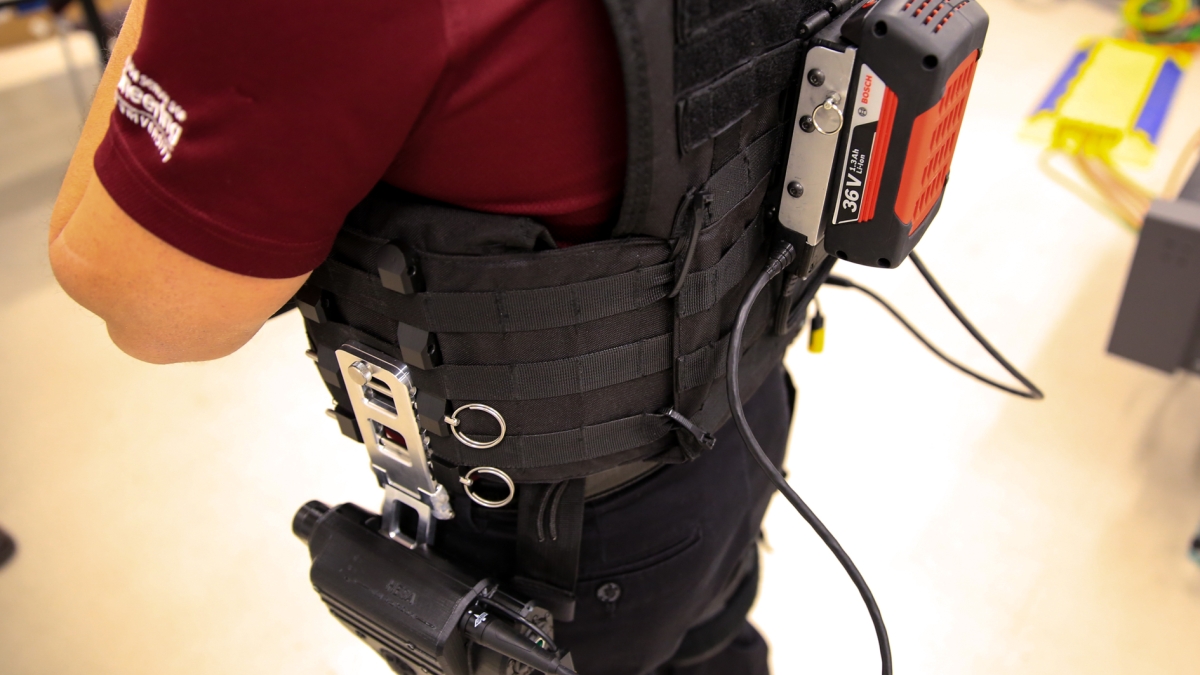ASU's Tom Sugar explores the next step in wearable robotics

ASU Professor Tom Sugar demonstrates his exoskeleton device in the lab.
Editor's note: Click here to read how one of Professor Tom Sugar's robotics creations did on the trail as a hiker puts it to the test.
Robots don’t have to be our mortal enemy. In fact, some are designed to enhance human life, like helping overcome disabilities or helping humans perform their jobs.
Tom Sugar, a professor in the Ira A. Fulton Schools of Engineering at ASU’s Polytechnic Campus, believes robots can improve the human condition. He has developed robotic prosthetics that help people lead normal lives, he has developed systems to cool a soldier and he is working on systems that can help humans perform their jobs.
The reason for the latter is not to take the job away, but to help the human work. For example, a warehouse worker can walk up to 18 miles per day just in doing his or her job, Sugar said. He has developed a device that could help that person.
On April 19–21, a large number of exoskeleton enthusiasts — those from industry, academia and government who are developing and marketing robotics you wear — will get together in Phoenix to talk about and show off some of their latest devices at WearRAcon17.
“Industry has talked to us about improving the quality of work, which can mean reducing fatigue or helping you work faster, but it can also mean reducing health-care costs,” Sugar said. “People are getting foot, shoulder or hip injuries by doing specific, repetitive tasks. If we can meld the ability of the human to make judgments, and change and solve problems, but then working directly with the machine to lift things and move things, we are making them more successful, more happy.”
One exoskeleton coming out of Sugar’s labs can help that warehouse worker beat fatigue. It is a lightweight (6.5 pounds total, including battery) device that you put on your back and strap to your legs.
“It works by giving you a push at the right time,” Sugar explained. “On your hips they assist the leg to go up into the air, and when your foot is on the ground they assist your leg pushing back to propel you forward. It reduces metabolic cost and fatigue. Most of the time, people walk 5 to 10 percent faster with the device.”
The beauty of the device is that even though it is strapped to you, it is not cumbersome.
“You don’t really notice it until you take it off; then you think, ‘I’m missing something,’” Sugar said. “That’s when you know you’ve got it right.”
WearRAcon17 will run from April 19 to 21 at the Hyatt Regency in Phoenix. Sugar and Joseph Hitt, of the Wearable Robotics Association, will host the show, and Sugar will make a presentation there as well.
More Science and technology

Breakthrough copper alloy achieves unprecedented high-temperature performance
A team of researchers from Arizona State University, the U.S. Army Research Laboratory, Lehigh University and Louisiana State…

4 ASU researchers named senior members of the National Academy of Inventors
The National Academy of Inventors recently named four Arizona State University researchers as senior members to the prestigious…

Transforming Arizona’s highways for a smoother drive
Imagine you’re driving down a smooth stretch of road. Your tires have firm traction. There are no potholes you need to swerve to…

